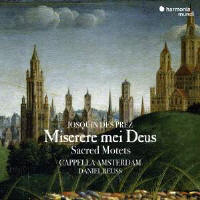Texte paru dans: / Appeared in: Harmonia Mundi |
|
|
Outil de traduction ~ (Très approximatif) |
|
|
Reviewer: J.
F. Weber
Titled Miserere mei, Deus, the
subtitle tells it all: Funeral Motets & Deplorations. (That French word
should have been translated as laments.) The program begins with Josquin’s
lament for Ockeghem and ends with Gombert’s lament for Josquin. The latter
has a significant claim to belong in this Josquin program. As the notes tell
it, for this motet Gombert used for his lament the tenor of Nimphes, nappés
(Circumdederunt me), taking it down a semitone. Josquin had done the same
with Ockeghem’s tenor (Requiem aeternam) when he used it for his lament,
Nymphes des bois. The difference of a semitone sounded completely different
to a musical initiate, as the notes put it, and composers of three
generations were linked in “a musical gesture of great finesse” (as it says
here).
The funeral motets in between
have a common thread if not much specificity. The beginning of St. John’s
gospel has the shape of prose poetry, but is not related to death so much as
to life. Absolve quaesumus is a prayer from the funeral rites, for which
Josquin uses the chant Requiem aeternam as a tenor. Next is Saul’s lament
for his son Absalom, followed by David’s lament for both, a perfect
juxtaposition found on records only from William Kempster and Konrad Ruhland.
(Kempster confused the link by following a recent notion that Pierre de la
Rue composed Absalon.) The penitential psalm that follows also uses Requiem
aeternam as the tenor, and another penitential psalm, Miserere mei, has the
chant of its own introductory words as the tenor. The combination of Pater
and Ave in one motet concludes the Josquin works. The notes comment on
almost none of this except the opening and closing laments. The one comment
that is made is unfortunate; the text of Absolve quaesumus, “whose precise
funerary function has not yet been elucidated,” is the collect that
concludes the brief ceremony of absolution (as the first words, the
imperative “absolve, we beg you,” indicate). It occurs at the end of Masses
for the Dead other than funeral Masses. All of the works are represented on records. Among the best previous versions are Nymphes des bois, Nimphes, nappés and Miserere mei by Lucien Kandel (Fanfare 37:5 for the first two) and Cinquecento (36:5); In principio erat Verbum and De profundis by Alexander Blachly (22:1); Absolve quaesumus by Edward Wickham (31:2); Absalon, fili mi by Peter Phillips (22:3); and Planxit autem David and Pater/Ave by Andrew Kirkman (25:4). The Gombert motet was recorded by Lucien Kandel and Cinquecento, along with three of these works as well as other laments for Josquin by Appenzeller and Vinders; by the Capella Josquin; by the Hilliard Ensemble and Jeremy Summerly (both 29:5); by Meinolf Brüser (28:6), Robert Rice, Clytus Gottwald, Bo Holten (12:3), and Bruno Turner (1:5, later on CD). As the citations of older reviews suggest, several pieces are not duplicated very much, so this collection is not only superbly performed but well developed on its theme. But the sum of the program is greater than its parts. Choosing a theme to be developed around a group of musical works is often attempted, but not so often achieved as well as this one is. I appreciated Reuss’s skill with this ensemble in Sweelinck (33:4), whose Huguenot psalms, I suggested, might fill a dozen CDs. Indeed, a couple of years later another group on another label did just that. Other than that disc, Reuss’s recordings are largely of 20th-century composers along with some Schubert and Mendelssohn. He is adept in earlier periods as well, as this recommendable disc proves. | |
|
|
|
|
Cliquez l'un ou l'autre
bouton pour découvrir bien d'autres critiques de CD |
|




